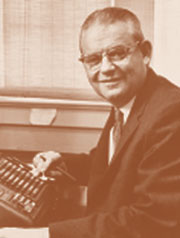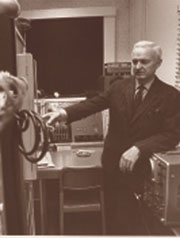

|
|
 Raymond Carhart
Raymond Carhart
 Helmer Myklebust
Helmer Myklebust
 Harold Westlake
Harold Westlake
|
A Leader in Audiology
Renowned in the scientific world but rarely recognized beyond those bounds, Northwestern’s Department of Communication Sciences and Disorders has been home to discipline-defining researchers and scientists. Raymond Carhart, Helmer Myklebust and Harold Westlake were among the founding fathers. “Northwestern is regarded as the place where audiology began,” says department chair Dean Garstecki. Raymond Carhart (GC34, 36), the “grandfather of audiology,” was one of the department’s first two PhD graduates — in speech pathology, experimental phonetics and psychology. He may be best known for developing and refining speech audiometry, the measure of hearing ability, particularly as it pertains to the efficiency of hearing aids. This research especially assisted war veterans, and Carhart, who served seven years as captain in the Medical Administrative Corps, knew their plight well. Soon after World War II the Veterans’ Administration named the Northwestern speech clinic the first of several agencies to assist war veterans with their speech and hearing. While Carhart set the standard for audiology, Helmer Myklebust sparked the study of learning disabilities. A professor at Northwestern from 1948, Myklebust focused on children who were born deaf or diagnosed as aphasic, those who lost the ability to communicate often as a result of brain damage. Later in his career he studied conditions caused by “psychoneurological learning disabilities” and developed a processing model for identifying and treating children with different learning disabilities such as dyslexia. He founded the Children’s Hearing and Aphasia Clinic at Northwestern in 1951. His peer Harold Westlake led groundbreaking research on the communicative disorders in children associated with cleft lip, cleft palate or cerebral palsy. While at Northwestern he helped establish the Cleft Lip and Palate Institute. Westlake served as president of the American Speech-Language-Hearing Association in 1952. He was also chair of the communication sciences and disorders department for 17 years. Westlake prodigy Hugo Gregory (C51, GC52, 59) led the study and treatment of stuttering or fluency disorders. Gregory developed the “Northwestern treatment approach” — encouraging the speaker to recognize and imitate other types of stuttering in small, easily understood fragments. In the 1980s he initiated an annual Northwestern-hosted workshop for
fluency disorder specialists that ran for more than a dozen years. —
Y.Y. |